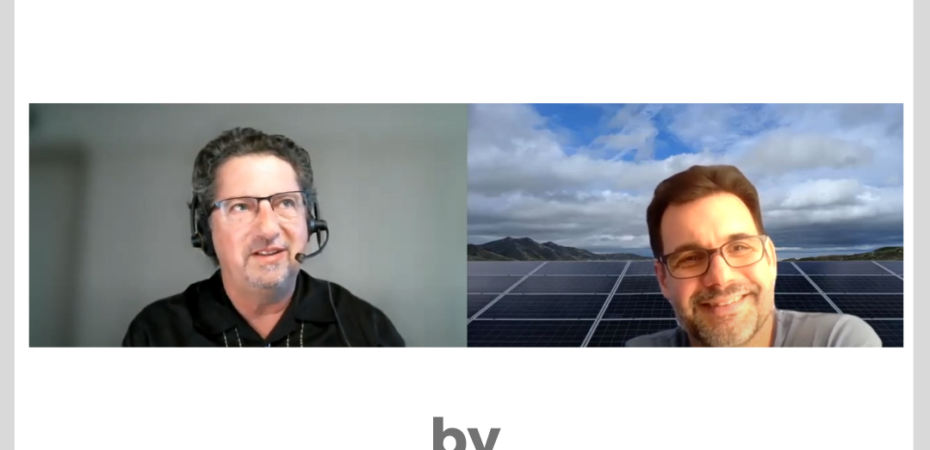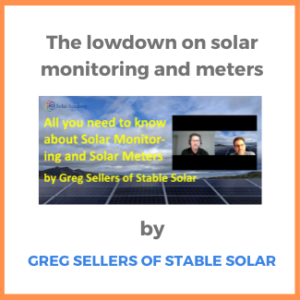We met with Greg Sellers of Stable Solar once again, this time to discuss solar monitoring and meters. Greg begins with a little background about the rise of monitoring in the industry and then delves into what to keep in mind around tracking system performance and ROI as well as actual energy use by the homeowner. The video is particularly useful for system owners and installers. Check out the 7 minute video.
Here is the transcript of the video.
Solar Academy: Hi, everyone, this is Kerim Baran with Solar Academy again, and I have with me Greg Sellers of Stable Solar again. This week we’re going to talk a little bit about solar monitoring and meters to monitor the performance of your solar system.
Sellers: Hi Kerim.
Solar Academy: Hi, Greg.
Sellers: I was thinking the other day and realized that it wasn’t too many years ago, when I first got into solar, it was not unusual but certainly wasn’t an expectation that a home solar system would have a monitoring process or have a meter at all. I used to manage a huge portfolio and I’d say fully half of the systems did not have any monitoring that the homeowner themselves could access .
Solar Academy: What years are we talking about?
Sellers: The early 2010s. I got into solar in ’07, ’08. It was because of the financing mechanisms. Systems were all being managed by the portfolio level. That’s what I did, and Sunrun and other companies like that would manage that for you. Also Tesla, SolarCity back then, partly because the technologies were not in parallel. It used to be that there was a whole separate technology infrastructure. There were these companies that were started that purely monitored the systems and then there was other companies that had the microinverters or central inverters and all that. And never the twain shall meet was the original decision
They started realizing, well, this is silly. So today it’s great because almost all the inverters, whatever type of inverter, has an integrated monitoring system that changed along with the change to loans and direct home ownership as the cost has gone down. This has all led to a situation where now the owner of the system is expected to and expects to have access to the power that’s being generated so they can watch that.
And the most obvious reason why you want to do that is that if your system stops performing, you’re not going to find out for months, because of the way true-ups work. It’ll be months down the road before you realize that your system hasn’t been generating power. It becomes a huge cost, obviously. So what we have, what I recognize, I think in terms of meters and the way that they’re inputted – I talked to homeowners every day, and what we realize is there are a few who are very knowledgeable and understand clearly what their system does. And they call and they say, “Hey, something’s wrong in my system, I’ve been monitoring it, and it doesn’t look like it’s doing what it’s supposed to.” That is still, though, less than 10% of any homeowners almost all the time.
I think there’s monitoring, or “Yeah, but I haven’t used it in a while, or I just bought the house and they told me everything was fine, I don’t have any access to the monitoring.” And so for all those situations, you basically may as well not even have a meter.
And so that I think the thing to keep in mind for homeowners is 1) despite your best intentions, down the road, it’s going to be hard for you to track it yourself. You’re not going to look at it as closely. We all have those apps on our phone that we checked every day for the first six months, we had it and now we look at it and go ,“Oh, that’s right, I still have that.” And yet we don’t think enough to do that.
So the easy solution to that is to have a company monitor it with you or for you. Sometimes installers, when they’re installing the system, they will be an admin on the system. And they’ll track. You have to make sure and ask them, though, “How are they tracking it? Are they watching it regularly themselves?” Because a lot of times they’ll do the same thing – won’t watch it, either.
If you’re purchasing it with a PPA or a lease, that kind of thing, they’re definitely going to watch it for you. The question to ask is to make sure what are the terms of that? Because we used to run into this situation where I would have to explain to customers that yes, your systems in 85%. But that still makes financial sense for us. So we’re not going to go out and spend the cost the significant cost to make it 100%. And that’s a hard conversation to have, but it’s what the contract said. So just keep that in mind.
But for the vast majority and the increasing majority of people who own their own systems, either through a loan or a purchase, they have to watch it themselves. And if their installer is not going to watch it, there’s other third party options. We’re one of them. We do a whole lot of that in a very low cost way. And one of the reasons we started Stable Solar was to help homeowners track performance, so that we can give them a heads up and give them options. There are other companies that do that as well. And so keep that in mind, Figure out a way that you can track that.
The other thing to keep in mind is, and this is very exciting development is, as we’ve seen the technology evolve, there are more and more opportunities for homeowners to not only track how much their solar is generating, how much income they’re generating from their solar installation, but also how much their house is using on a regular basis. It used to be common that folks would get solar and suddenly they go nuts and turn every electrical outlet on in the house, because “Now I have solar, I can use it all”, and then they’d be shocked at the bill. Fewer folks do that these days.
But the reality is, we all have uses that we don’t quite realize how much it uses. There’s that generator that we’d forgotten about, some resource that’s sitting in the corner somewhere that we didn’t even remember was generating power that is actually turning out to use a lot.
Now you can generate that there’s new main service panels like Span that are great at allowing you to do that on a very granular, per breaker level. There are meters, we have a lot of installs with meters like Sense and Emporia that are very simple, where they attach to the breakers that you choose. Y,ou can say I want to monitor a refrigerator, I want to monitor my air conditioner, and it will track those and then you can go on your app and look at those as well. So and you can share those as well too.
So that you can maybe you get a call saying, “Hey, looks like something’s going crazy with your air conditioning and spiked and you know, and then this is March, what’s going on?” So you can keep an eye on those as well. Those are a few things to keep in mind. But the main thing I think is just to know that, you know, knowledge is power when it comes to literally power. When it comes to meters, and you should either have one that you use or find a partner that will make sure that you’re using the resources you have to keep that power being monitored so that you can enjoy the long term benefits of solar.
Solar Academy: Thank you for this information.
Sellers: Great, Kerim.


